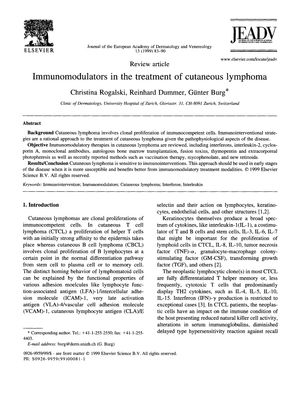Immunomodulators in the Treatment of Cutaneous Lymphoma
September 1999
in “
Journal of the European Academy of Dermatology and Venereology
”
cutaneous lymphoma immunomodulatory therapies Interferon-alpha IFN-α CTCL high-dose IL-2 mycophenolate mofetil cyclosporin A monoclonal antibodies autologous BMT fusion toxins thymopentin retinoids ECP extracorporeal photopheresis vaccination therapy DAB 389 IL-2 erythrodermic CTCL cutaneous lymphoma Interferon-alpha IFN-α CTCL IL-2 mycophenolate mofetil cyclosporin A monoclonal antibodies BMT fusion toxins thymopentin retinoids ECP extracorporeal photopheresis vaccination therapy DAB 389 IL-2 erythrodermic CTCL

TLDR Immunomodulatory therapies are effective for treating cutaneous lymphoma, particularly in early stages.
The document reviews various immunomodulatory therapies for cutaneous lymphoma, highlighting that the disease is sensitive to such treatments, especially in early stages. Interferon-alpha (IFN-α) is the most commonly used treatment, with a partial response rate of 45% in CTCL patients at a dose of 50 MU/m² three times a week, though lower doses are also effective and less toxic. Side effects of IFN-α and the development of neutralizing antibodies are noted concerns. Other treatments like high-dose IL-2 and mycophenolate mofetil show promise, while cyclosporin A is not recommended. Monoclonal antibodies, autologous BMT, fusion toxins, thymopentin, retinoids, ECP, and vaccination therapy are also discussed. BMT resulted in complete remissions in 13 out of 23 subjects but is not recommended due to relapse. DAB 389 IL-2 fusion toxin showed some complete responses with fewer side effects. ECP is standard for erythrodermic CTCL with a 50-75% response rate. The document concludes that immunointerventions are effective and that a deeper understanding of CTCL pathogenesis could lead to new treatments.





